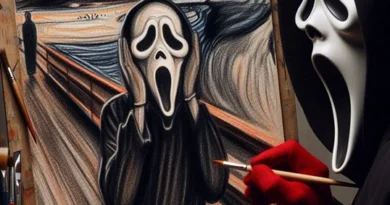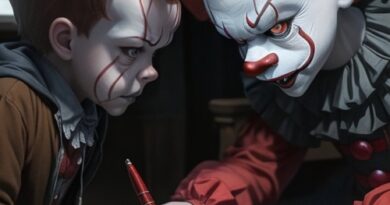Art On Fire: The Mystery Behind The Crying Boy Painting
It’s a story that seems to have come out of a horror movie: in fact, we know several movies with a very similar idea, belonging to a sub-genre we can call “cursed objects”. The principle is simple: a certain object causes acts of destruction and loss when all attempts to get rid of that destructive object meet with complete failure. Our reality includes several such objects, at least if you ask those who believe or want to use these stories for personal purposes.
The Crying Boy is a series of paintings that are supposed to be haunted, at least on paper (or cardboard, in this case). Is there something to these horror stories, or is The Crying Boy Painting “Curse” no more than an urban legend, designed mainly to sell newspapers?
That’s How The Crying Boy Painting Story Began
To understand what is behind the paintings of the crying boy, you have to go back a few decades: to the 70s and 80s of the 20th century, to be more precise. In these years, portraits were common in the UK, and in many places in the world, mostly purchased at the local flea markets. These paintings presented a figure of a boy, wearing a coat.
On the cheeks of this boy, as you probably already understood, there were tears. It is a series of hundreds of portraits, mostly of boys. They looked straight ahead with sad or serious expressions, and the impression created is that the boy in the portrait is looking straight at the people looking at him. And by the way, although the children who appeared in these portraits were nicknamed “Gypsies”, it is not clear if all of them really were like that.
The Crying Boy painting series is attributed to an Italian painter Bruno Amadio, or by his other brush names: Giovanni Bragolin or Franchot Sevilla. We will align with the name more identified with him, and call him simply Bragolin. Either way, this is a painter, born in Venice, who underwent academic training. After the Second World War, he worked in Venice as a painter and was engaged in the reproduction of artworks. According to conventional wisdom, he produced pictures of crying children for tourists who came to Italy.
Commercially, the paintings are considered unique. At some point, according to some reports, Bragolin sold the rights to his works to a British company. The paintings were reproduced and sold in commercial quantities. These paintings were among the first to be reproduced in color on a huge scale in the 1960s, but most are not signed or dated. The original painter won almost no rewards for the works (or in fact – their copies) that were a huge success. Countless merchants offered a picture of the crying boy for sale, the painting was also sold in markets and found its place in countless homes.
💀 Killer Deals & Scary Recommendations 💀
🎭 Costumes & Accessories
HalloweenCostumes Fun Costumes Entertainment Earth
🛒 Online Shopping
AliExpress Amazon Walmart Etsy
🧛 Collectibles & Horror Brands
Funko Hot Topic Lego Spirit Halloween
🎢 Attractions & Tours
GetYourGuide Tiqets Viator Klook
📖 Blogs & Horror Sites
Bloody Disgusting iHorror Fangoria
🩸 Disclaimer: Some links are affiliate links. The price stays the same – it just helps keep the site alive 👻
The Tragedy Of The “Real” Crying Boy?
According to Bragolin, one of the main subjects of the painting was a mute orphan he met in Madrid in the 1960s named Don Bolino. The painter was drawn to the look of sadness in the boy’s eyes, which later turned out to be due to the terrible circumstances of his parents’ death: they were burned to death, while their son managed to escape. A local priest warned him to stay away from the boy, who allegedly caused fires from an unknown source wherever he went. He also gave him the unflattering nickname “Diablo”, meaning devil. As in any good horror story, Amadeo/Bragolin/Seville ignored the warnings, adopted the boy, and made him one of the subjects of his paintings.
One day, Bragolin’s apartment and studio inexplicably caught fire. He lost all his possessions, blamed the boy, and kicked him out of his home. They never saw each other again. In 1976, a car accident occurred in the suburbs of Barcelona. A car crashed into a wall and caught fire. The driver, the only passenger in the vehicle, was completely burned to the point where the body was undetectable. The officers checked the glove compartment, which was not damaged by the fire, and found a driver’s license with the name Don Bolino on it. Many believe this is what started the curse of the crying boy paintings.
The Curse Of The Crying Boy
Over the years, various urban legends about the mysterious painter have spread. Some have criticized Bragolin for portraying the horror, distress, and suffering of “pure” children. Some wondered how exactly the children got the sad expression that appeared in the pictures and that made them cry. Among other things, there were speculations that he used to scare or put fear in the children before he photographed them. The extremists even claimed that he was expressing the embodiment of Satan. Another myth was that Bragolin escaped to Spain and created portraits of the children of an orphanage that burned down shortly after (later we will return to the fire motif). It seems he apparently stayed in Italy and engaged in painting for a long time. He passed away in September 1981, but if you ask urban legend fans – his paintings still live on, unfortunately.
From the 1980s, horror stories began to link The Crying Boy painting with a mysterious curse, or even magic. It started with an article in the British “Daily Star” about a fire that occurred in the town of Rotherham in South Yorkshire, England. The first floor of the house was completely burned, but there was one item that remained intact – a picture of the crying boy. The painting detached from the wall and fell to the ground, with its face towards the floor. The couple, Ron and Mary Hall, were prepared to swear that it was the photo that caused the fire, although it was later found that a wayward chip pan was to blame.
In those years, and to this day, there was a war between the British tabloids. “The Sun”, the competitor of the “Daily Star”, fought back. He published a similar story a little later about a woman who bought the painting and saw her house burned down shortly after. Bizarre stories began to emerge, about terrible accidents that happened after the purchase of the painting: fires, a woman who claimed that the painting was the cause of a car accident in which her husband and three daughters perished, another woman who claimed that the painting caused the mutilation of her child’s genitals. Some also attributed paranormal activity to the paintings, such as unexplained movements or paintings that returned to their place and natural appearance after being burned.
When The Media Increased The Flames
As the weeks passed, more and more articles appeared on the subject of the drawing of the crying child. A central part of the panic was caused by a comprehensive article that included a quote from fire officials, who claimed to have encountered about 50 such fires in homes, offices, and even a pizza stand. There was seemingly a common denominator in all the fires: one of the main remains that remained was the picture of the crying child, which in some cases remained hanging on the wall and in others fell to the floor, but almost unharmed. According to the article, some firefighters openly talked about The Crying Boy painting curse. Word of the brutal painting spread around the world like wildfire. A real hysteria arose around the painting. Some tried to burn their painting but failed.
At one point, the editor of The Sun, Calvin McKenzie, solemnly announced: “That’s enough, friends! If you fear a picture of a crying child hanging in your house, send it to us immediately. We will destroy it for you so that we leave every curse behind.” Readers responded to this request. The highlight was a public ceremony, initiated by “The Sun”, in which hundreds of paintings from the Crying Boy series were ceremoniously burned in a huge bonfire near the Thames River, under the supervision of the fire department.
Here is a video of a guy trying, and not quite succeeding, to burn a picture of the crying child:
The Crying Boy Painting: Science VS Horror
So what exactly happened there? When you look at the English press, then and now, you can make a few guesses. Credibility is not recognized in too many British tabloids, and the writer of these lines – who also happens to be a fan of the Liverpool football team, which was defamed by the “Sun” after the Hillsborough disaster scandalously and falsely – knows it very well. It is very possible that some of the stories were made up or at least inflated.
The fire services in South Yorkshire didn’t deny some paintings survived fires but provided a more logical explanation to The Crying Boy painting so called curse. They investigated dozens of cases and pointed to various culprits: cigarettes, frying pans, bad wiring, and so on. Not in all cases could they explain why the paintings survived. The Rotherham fire station officer’s wife was convinced that the reason was related to the contents of the paints themselves: “I always say it’s the tears that put the fire out.”
In a message published by the fire services at one point, they claimed the paintings did not burn because of their raw material – extremely thick sheets of compressed cardboard – which is not considered flammable. Some paintings were coated with lamination, a material known as a flame retardant. Although these explanations seem very reasonable, not everyone accepted these claims. Enthusiasts of supernatural phenomena explained that when we draw a person, a part of his soul passes into the painting. In our case, the children didn’t really like they were drawn in difficult moments, when they were crying or even scared, and decided to take revenge on anyone who hangs The Crying Boy pictures on their walls. Over time the interest surrounding the mysterious images began to wane. That’s how it is when there’s a new big story to tell.
Even in the years that have passed since then, the painting of the crying boy have aroused interest more than once. It starts with a Brazilian talk show, somewhere in the 80s. A mysterious man arrived, introduced himself as the same missing painter, and claimed that the theories about something malicious in these paintings were true. That man, who had probably seen one horror movie in his life, claimed that he made a pact with the devil, as part of which he was asked to incorporate malicious messages into paintings.
Today, The Crying Boy picture is mostly nostalgic memory. Today, you can still find some versions of The Crying Boy painting for sale easily, although the demand is almost non-existent. Today, many of us prefer to place wall pictures of our children laughing, in the most beautiful moments of their lives, and not of unknown children crying. And the curse of The Crying Boy paintings?? They probably belong to the past or horror movies. Maybe it’s time for someone to pick up the gauntlet and make us a horror movie about this story, isn’t it?








